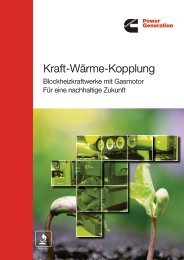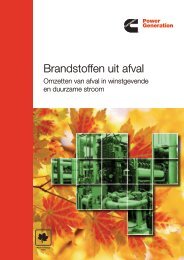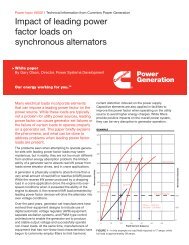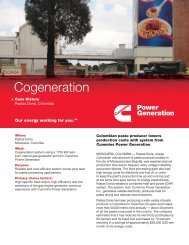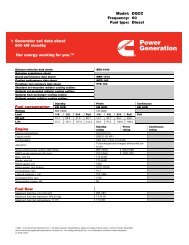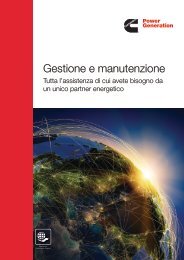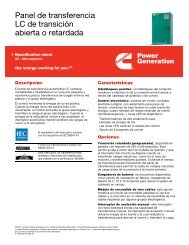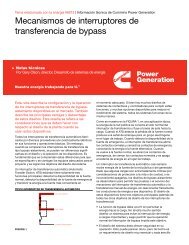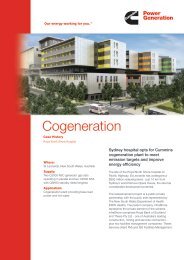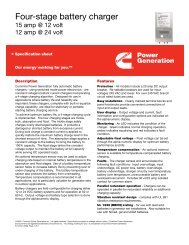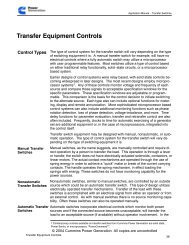appendix
appendix
appendix
You also want an ePaper? Increase the reach of your titles
YUMPU automatically turns print PDFs into web optimized ePapers that Google loves.
Application Manual – Liquid Cooled Generator Sets<br />
Harmonics<br />
Harmonics are voltage or current components which operate at integral multiples of the<br />
fundamental frequency of a power system (50 or 60 Hertz). Harmonic currents have the<br />
effect of distorting the shape of the voltage wave form from that of a pure sine wave.<br />
Hertz (Hz)<br />
The term Hertz is the preferred designation for cycles per second (CPS).<br />
Hunting<br />
Hunting is a phenomenon that can occur upon load changes in which the frequency or<br />
the voltage continues to rise above and fall below the desired value without reaching a<br />
steady–state value. It is caused by insufficient damping.<br />
Insulation<br />
Insulation is non–conductive material used to prevent leakage of electric current from a<br />
conductor. There are several classes of insulation in use for generator construction, each<br />
recognized for a maximum continuous–duty temperature.<br />
Jerk<br />
Rate of change of acceleration. Often used as a measure of performance in elevator<br />
systems.<br />
kVA (kilo–Volt–Amperes)<br />
kVA is a term for rating electrical devices. A device’s kVA rating is equal to its rated<br />
output in amperes multiplied by its rated operating voltage. In the case of three–phase<br />
generator sets, kVA is the kW ouput rating divided by 0.8, the rated power factor. KVA is<br />
the vector sum of the active power (kW) and the reactive power (kVAR) flowing in a<br />
circuit.<br />
kVAR (kilo–Volt–Amperes Reactive)<br />
KVAR is the product of the voltage and the amperage required to excite inductive circuits.<br />
It is associated with the reactive power which flows between paralleled generator<br />
windings and between generators and load windings that supply the magnetizing currents<br />
necessary in the operation of transformers, motors, and other electromagnetic loads.<br />
Reactive power does not load the generator set’s engine but does limit the generator<br />
thermally.<br />
kW (kilo–Watts)<br />
KW is a term used for power rating electrical devices and equipment. Generator sets in<br />
the United States are usually rated in kW. KW, sometimes called active power, loads the<br />
generator set’s engine.<br />
kW• h (kilo–Watt–hour)<br />
This is a unit of electric energy. It is equivalent to one kW of electric power supplied for<br />
one hour.<br />
Lagging Power Factor<br />
Lagging power factor in AC circuits (a power factor of less than 1.0) is caused by<br />
inductive loads, such as motors and transformers, which cause the current to lag behind<br />
the voltage. See Power Factor.<br />
Leading Power Factor<br />
Leading power factor in AC circuits (0.0 to –1.0) is caused by capacitive loads or<br />
overexcited synchronous motors which cause the current to lead the voltage. See Power<br />
Factor.<br />
Leg<br />
A leg is a phase winding of a generator, or a phase conductor of a distribution system.<br />
Line–To–Line Voltage<br />
Line–to–line voltage is the voltage between any two phases of an AC generator.<br />
G–6 APPENDIX G<br />
Rev. Jan 2011



